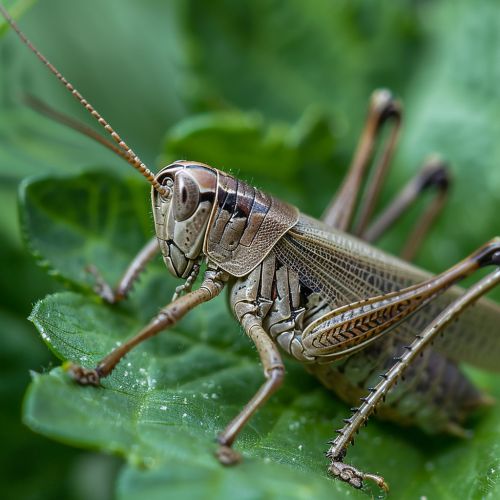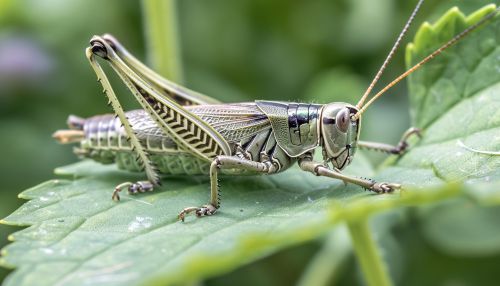Grasshoppers
Introduction
Grasshoppers are a group of insects belonging to the suborder Caelifera, within the order Orthoptera. They are known for their powerful hind legs which enable them to leap great distances. Grasshoppers are primarily herbivorous and can be found in a variety of habitats including grasslands, forests, and agricultural fields. Their ability to consume large quantities of vegetation makes them both a significant agricultural pest and an important component of the ecosystem.
Taxonomy and Classification
Grasshoppers belong to the suborder Caelifera, which is part of the larger order Orthoptera. The Orthoptera order also includes crickets and katydids. The Caelifera suborder is divided into several families, with the most notable being Acrididae, which contains the majority of grasshopper species. Other families include Tetrigidae (pygmy grasshoppers), Tridactylidae (pygmy mole crickets), and Eumastacidae (monkey grasshoppers).
Morphology
Grasshoppers exhibit a range of morphological features that are adapted to their environment and lifestyle. They possess a robust exoskeleton, segmented body, and three pairs of legs. The hind legs are particularly well-developed for jumping. Their wings, if present, are usually membranous and can be folded over the body. Grasshoppers have compound eyes, which provide a wide field of vision, and antennae that are typically shorter than their body length.


Physiology
Grasshoppers have a highly specialized digestive system adapted to their herbivorous diet. Their mouthparts are designed for chewing, and they have a crop and gizzard for grinding plant material. The respiratory system consists of a network of tracheae that deliver oxygen directly to tissues. Grasshoppers also have an open circulatory system, where hemolymph circulates freely within the body cavity.
Behavior
Grasshoppers are primarily diurnal and rely on their powerful hind legs for locomotion. They exhibit a range of behaviors including mating rituals, territorial displays, and escape responses. Grasshoppers communicate through a combination of visual signals and stridulation, where they produce sound by rubbing their hind legs against their wings.
Reproduction
Grasshoppers reproduce sexually, with males often engaging in complex courtship behaviors to attract females. After mating, females lay eggs in the soil or within plant material. The eggs undergo a period of diapause, which allows them to survive unfavorable environmental conditions. Upon hatching, the nymphs undergo several molts before reaching adulthood.
Ecology
Grasshoppers play a crucial role in their ecosystems as both herbivores and prey. They help regulate plant populations and serve as a food source for a variety of predators including birds, reptiles, and small mammals. However, in large numbers, grasshoppers can become pests, causing significant damage to crops and vegetation.
Economic Impact
Grasshoppers can have a substantial economic impact, particularly in agricultural settings. Outbreaks of grasshopper populations can lead to severe crop losses, necessitating the use of pest control measures. Integrated pest management strategies, including biological control and habitat manipulation, are often employed to mitigate the damage caused by grasshoppers.
Conservation
While some grasshopper species are considered pests, others are of conservation concern. Habitat loss, climate change, and pesticide use are significant threats to grasshopper populations. Conservation efforts focus on habitat preservation, sustainable agricultural practices, and research into the ecological roles of grasshoppers.
